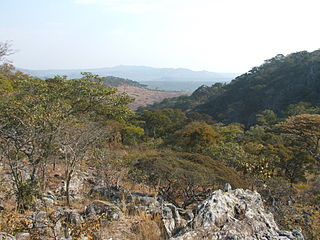Related Research Articles
The Nsenga, not to be confused with the Senga, are a Bantu ethnic tribe of Zambia and Mozambique. In Zambia, they are found in two districts of Eastern province namely Nyimba and Petauke. They are also dialects with the Nsenga Luzi of the Luangwa valley in Chief Nyalugwe, Mboloma and Lwembe and the Chikunda of Luangwa Boma (Feira). Their Senior Chief is Kalindawalo M'ndikula who resides in Merwe 10 kilometers from Petauke Boma. His subjects include Chief Mwape, Nyamphande, Nyanje, Mumbi, Sandwe, Nyalugwe, Ndake, Lwembe and Mwanjaw'anthu. They are well known for their culture and artwork which includes bead work and basketry. They also grow groundnuts, maize, millet and sorghum for consumption and cotton (Thonje) as cash crop, and are popular for their Mbewa (Mice), a practice which they are often teased for. The Nsenga language spoken by people of this tribe has been adopted by many groups in Zambia and diluted to Zambia’s widely spoken language Chinyanja.

Central Province is one of Zambia's ten provinces. The provincial capital is Kabwe, which is the home of the Mulungushi Rock of Authority. Central Province has an area of 94,394 km (58,654 mi). It borders eight other provinces and has eleven districts. The total area of forest in the province is 9,095,566 ha, and it has a national park and three game management areas. The first mine in the region was opened up in 1905 making the then Broken Hill town the first mining town. In 1966, he town's name was reverted to its indigenous name - Kabwe meaning 'ore' or 'smelting'.

The Ovambo language is a dialect cluster spoken by the Ovambo people in southern Angola and northern Namibia, of which the written standards are Kwanyama and Ndonga.

The 250 or so "Narrow Bantu languages" are conventionally divided up into geographic zones first proposed by Malcolm Guthrie (1967–1971). These were assigned letters A–S and divided into decades ; individual languages were assigned unit numbers, and dialects further subdivided. This coding system has become the standard for identifying Bantu languages; it was the only practical way to distinguish many ambiguously named languages before the introduction of ISO 639-3 coding, and it continues to be widely used. Only Guthrie's Zone S is (sometimes) considered to be a genealogical group. Since Guthrie's time a Zone J has been set up as another possible genealogical group bordering the Great Lakes.

Mkushi District is a district of Zambia, located in Central Province. The capital lies at Mkushi. As of the 2010 Zambian Census, the district had a population of 148,814 people. The Great North Road runs through Mkushi district, connecting Kapiri Mposhi and Serenje districts. The area is largely undeveloped and home to numerous natural attractions including Lunsemfwa Wonder Gorge, Changwena Falls, and historic Fort Elwes.
The Twa of the Kafue Flats wetlands of Zambia are one of several fishing and hunter-gatherer castes living in a patron-client relationship with farming Bantu peoples across central and southern Africa.
The Sabi languages are a group of Bantu languages established by Christine Ahmed. They constitute much of Guthrie's Zone M, plus Senga. The languages, or clusters, along with their Guthrie identifications, are:
Yans (Yanzi) is a Bantu language spoken in the Democratic Republic of the Congo by the Bayanzi.
Bisa may refer to:
Samia (Saamia) is a Bantu language spoken by the Luhya people of Uganda and Kenya. Ethnologue includes Songa as a dialect, but it may be a separate language.
Kuvale is a Southern Bantu language spoken in Angola, in the middle of a large Umbundu -speaking area. It has traditionally been considered a dialect of Herero; however, Maho (2009) has moved it from Bantu Zone R.30 to Zone R.10, which includes Umbundu and a few smaller languages. Ngendelengo may be a distinct language.
Lwalu, also known as Lwalwa, is a Bantu language of the Democratic Republic of the Congo. Its classification is uncertain: Nurse (2003), following Ahmed (1995), assigns all of Guthrie's L.20 languages to Luban, including Lwalu.
Nkoya is a Bantu language of Zambia. It may be one of the Luba languages, and is at least Luban.
Lala is a Bantu language of South Africa, claimed to be extinct in some sources. As of 1999, however, there were still a number of communities of speakers in the coastal regions of the KwaZulu-Natal province of South Africa. Although it is a Tekela Nguni language, for sociological reasons it is often considered a dialect of Zulu, whereas it differs quite markedly in phonology and to a degree in morphology, and with a large portion of its lexicon derived from Xhosa and the IsiZansi Tekela variety of the lower South Coast.
Binji is a Bantu language of eastern Democratic Republic of the Congo. Maho (2009) states that it is close to Songe, which is otherwise isolated within the Luban languages established by Ahmed (1995).
Ngando is a Bantu languages of the Central African Republic.
Lala language may refer to:
Kwangwa (Kwanga) is a Bantu language of Zambia.
The Lala people are a Bantu ethnic group found in the Serenje District of the Central Province of Zambia.
References
- ↑ Lala-Bisa at Ethnologue (18th ed., 2015) (subscription required)
- ↑ Jouni Filip Maho, 2009. New Updated Guthrie List Online